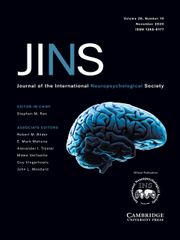Regular Research
Double Dissociation of Auditory Attention Span and Visual Attention in Long-Term Survivors of Childhood Cerebellar Tumor: A Deterministic Tractography Study of the Cerebellar-Frontal and the Superior Longitudinal Fasciculus Pathways
-
- Published online by Cambridge University Press:
- 28 April 2020, pp. 939-953
-
- Article
- Export citation
Memory Performance and Quantitative Neuroimaging Software in Mild Cognitive Impairment: A Concurrent Validity Study
-
- Published online by Cambridge University Press:
- 28 April 2020, pp. 954-962
-
- Article
- Export citation
Empathy and Theory of Mind in Alzheimer’s Disease: A Meta-analysis
-
- Published online by Cambridge University Press:
- 20 May 2020, pp. 963-977
-
- Article
- Export citation
Eye Movements and White Matter are Associated with Emotional Control in Children Treated for Brain Tumors
-
- Published online by Cambridge University Press:
- 27 May 2020, pp. 978-992
-
- Article
- Export citation
Dual-Task in Large Perceptual Space Reveals Subclinical Hemispatial Neglect
-
- Published online by Cambridge University Press:
- 27 May 2020, pp. 993-1005
-
- Article
-
- You have access
- Open access
- HTML
- Export citation
The INECO Frontal Screening for the Evaluation of Executive Dysfunction in Cerebral Small Vessel Disease: Evidence from Quantitative MRI in a CADASIL Cohort from Colombia
-
- Published online by Cambridge University Press:
- 03 June 2020, pp. 1006-1018
-
- Article
- Export citation
Is There a Functional Relation Between Set Shifting and Hyperactivity in Children with Attention-Deficit/Hyperactivity Disorder (ADHD)?
-
- Published online by Cambridge University Press:
- 27 May 2020, pp. 1019-1027
-
- Article
- Export citation
Performance Validity Testing in Multiple Sclerosis
-
- Published online by Cambridge University Press:
- 28 April 2020, pp. 1028-1035
-
- Article
- Export citation
Investigation of the Clinical Utility of the BRIEF2 in Youth With and Without Intellectual Disability
-
- Published online by Cambridge University Press:
- 09 July 2020, pp. 1036-1044
-
- Article
- Export citation
Brief Communication
Assessment of Prorated Scoring of an Abbreviated Protocol for the National Institutes of Health Toolbox Cognition Battery
-
- Published online by Cambridge University Press:
- 21 October 2020, pp. 1045-1050
-
- Article
-
- You have access
- Open access
- HTML
- Export citation
Addendum
Discrepancy-Based Evidence for Loss of Thinking Abilities (DELTA): Development and Validation of a Novel Approach to Identifying Cognitive Changes – Addendum
-
- Published online by Cambridge University Press:
- 18 June 2020, p. 1051
-
- Article
- Export citation
Corrigendum
The INECO Frontal Screening for the Evaluation of Executive Dysfunction in Cerebral Small Vessel Disease: Evidence from Quantitative MRI in a CADASIL Cohort from Colombia – Corrigendum
-
- Published online by Cambridge University Press:
- 24 September 2020, p. 1052
-
- Article
-
- You have access
- HTML
- Export citation
Front Cover (OFC, IFC) and matter
INS volume 26 issue 10 Cover and Front matter
-
- Published online by Cambridge University Press:
- 09 November 2020, pp. f1-f2
-
- Article
-
- You have access
- Export citation
Back Cover (OBC, IBC) and matter
INS volume 26 issue 10 Cover and Back matter
-
- Published online by Cambridge University Press:
- 09 November 2020, pp. b1-b3
-
- Article
-
- You have access
- Export citation

